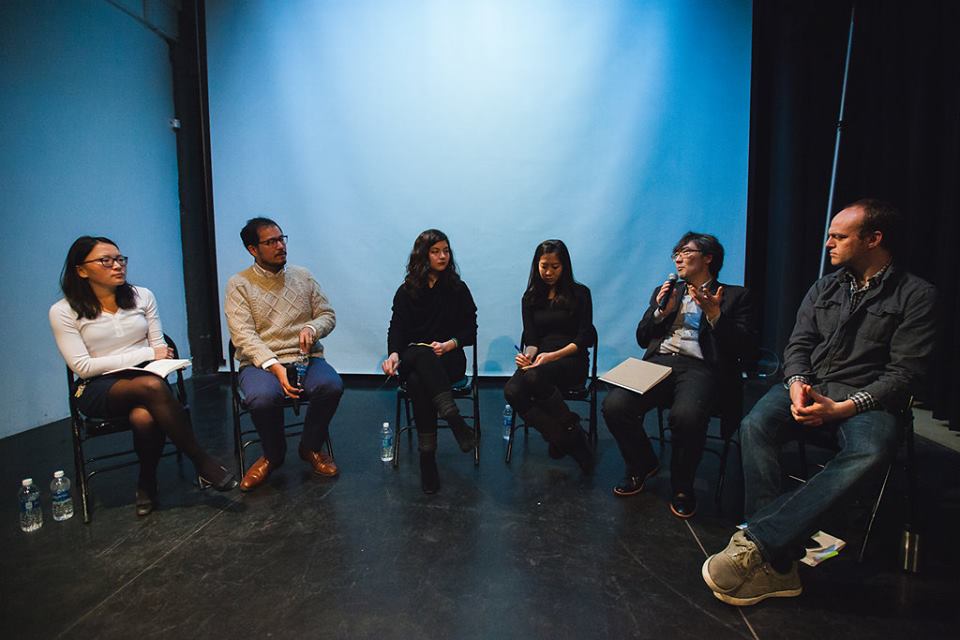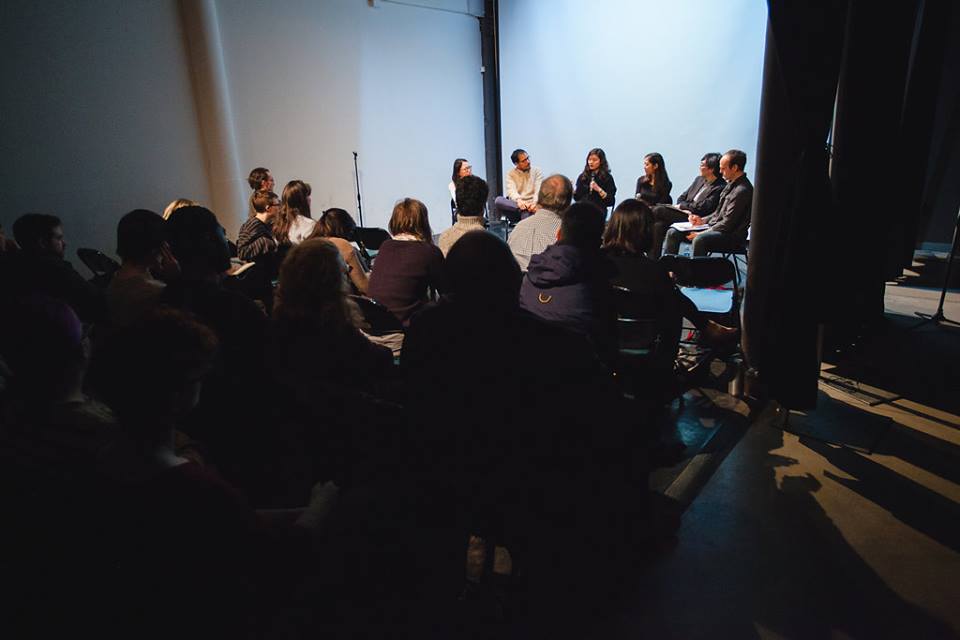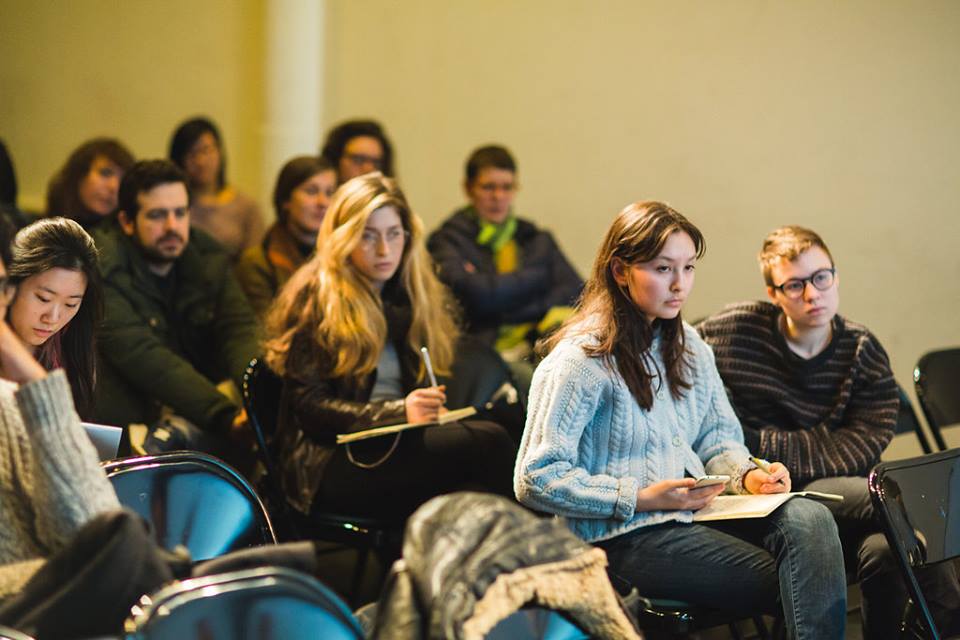There were two great panel discussions at Asian Arts Initiative last Saturday February 13: Falling In with Dan S. Wang and “Organize Your Own?” a panel on the work
of four Asian American Socially-Engaged Artists. Asian Arts Initiative is an arts space for exhibitions, performances, artist residencies, youth workshops, and community gatherings. I’ve gone to quite a few open discussions at AAI and have come to appreciate this small intimate setting. I only caught the tail end of the Falling In discussion which started at 12:30pm because I had attended the ASA brunch. I was able to stay for the full 3-5pm panel though.
For the first event, Dan S. Wang lead a workshop based on his project for the Organize Your Own exhibition entitled “Falling In: American Counterculture for Chinese Nationals” which featured a reading and film syllabus composed as if for a semester long college course aimed towards introducing American Counterculture to Chinese international students studying in the USA. I was interested in this panel because Bryn Mawr has a very big population of Chinese international students (I would estimate it to be around 17%). I also wanted to know more about American Counterculture and how to teach such a complicated subject.
“The crises of yesterday are not the crises of today. The political coherence of today will therefore be different. Without a political coherence of a sort, the term Asian American turns ahistorical and therefore hollow.” — Dan S. Wang
I think the purpose of the event was to learn more about Dan’s intentions behind the syllabus and to critique the syllabus. (The syllabus can be found here.) Dan told us that he did not have much interaction with Chinese international college students, but that through his informal conversations with a Chinese student who studied in the USA, he found that Chinese students returned to China more anti-American. (I wouldn’t necessarily say this is a bad result, but I do think that American history is very complex and a crash course in American social issues would be well received.) From my own experience talking to my international Chinese friends at Bryn Mawr, they are not more anti-American nor more pro-China. They understand the context of learning about China through an American lens, but even I have trouble reconciling America’s view of China with the experiences of Asian Americans and Asians in America (often about racism). One person mentioned that the relationship between instructor and student would have to be clarified because this relationship is very different in China. Another person suggested adding field trips and community volunteering events to the course. My critique of the syllabus was that there was no comparative element to China’s counterculture movements. For example, Tiananmen Square happened in China, but it had an effect on American counterculture and even counterculture in East Central Europe during the Fall of the Soviet Union.
I also believe an introduction to American countercultures course specifically designed for Chinese and Asian students is important in building solidarity within the Asian community. The most recent split within the community that I have been thinking about a lot is over Peter Liang, the Chinese American NYPD officer convicted for second-degree manslaughter for the Nov. 20, 2014 death of Akai Gurley, an unarmed Black man. I noticed that some of my Chinese international and Asian American Facebook friends had shared on their Facebook walls posts in opposition of Liang’s indictment (see Many Asians Express Dismay and Frustration After Liang Verdict and Why Many Asian Americans Support Conviction of Peter Liang). I could see why in cases like these, you would feel anti-American for such institutional failures. Many of my Asian American friends, including myself, feel that their anger is justified in that the criminal justice system is unfair toward non-Whites, but that ultimately we must fight anti-Black racism within the Asian community by supporting the indictment of Liang and the indictments of all people who shoot unarmed, innocent people, particularly Black people. I am curious as to how Dan S. Wang would include current events like these into the syllabus, even as the world keeps on changing.
The second session was a panel discussion with Asian American artists Emily Chow Bluck, Aletheia Hyun-Jin Shin, Dan S. Wang, and Rosten Woo. They each explained their career paths as artists and their past and current projects. A main focus of the panel was how their identity (either as an insider, outsider, or sometimes both) shaped how they got involved with their own communities and other communities. Emily Chow Bluck and Aletheia Hyun-Jin Shin talked about their work with a Baltimore food center making Chee Chee as a comfort food for formerly incarcerated men. They also did a project where they interviewed Asian convenience store owners in primarily Black or Latino neighborhoods and how they gave back to the community that was different from their own. I thought their art work was an interesting mix of food, belonging, health, and service. Dan S. Wang talked about his experience growing up as the only Chinese kid in Michigan and how he became interested in examining historical events centered around Detroit and the Asian American experience. Rosten Woo talked about incorporating technical skills like graphic design and GIS to make print materials and resources (such as the census –> yay biostats) more accessible for different target audiences based on race, class, education levels, etc.
The panel ended with a Q&A. One person asked how she could become more involved in her communities as an artist. The artists’ responses were funny, but all too real. “1. Reduce your standard of living. 2. Recognize your privilege (or lack of) and identity. 3. Start with an existing organization.”





Your point about parallels from Chinese history is well taken. I addressed it a couple of times during the workshop, probably during the time you missed. I spoke about there being a long history of drop-out subcultures in China, going back centuries. As well, the woodcut poster I made for the show Organize Your Own show quotes from a print by Hu Qizao, an artist identified with the Woodcut Movement of China in the 1920s and 30s, one of China’s 20th century avant garde currents. So I was imagining myself teaching such a course and having it be suffused with references to Chinese countercultures, but not needing formalized instruction (apart from the opening and closing lectures as set out in the syllabus). As this project moves ahead, I may have to revise the syllabus or add another short reading list to cover the China side.
Thank you for correcting me, I realize I missed out on a lot by coming late. I really enjoyed your panel. Good luck on the syllabus!